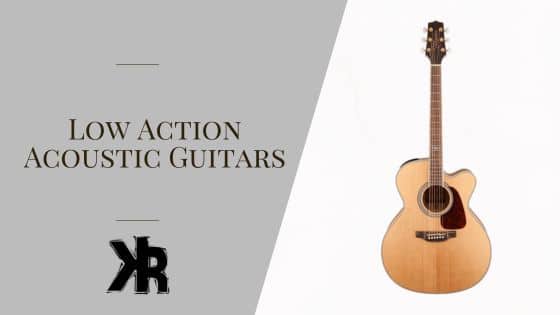Table of Contents
Guitars vary in shape, size, and type, each with its own characteristics. The action of a guitar, defined as the distance between strings and fretboard, is an important aspect to consider.
This Killer Rig article focuses on low action acoustic guitars, favored for their ease of play, particularly for beginners. Low action means the strings are closer to the fretboard, requiring less finger pressure and facilitating easier playing.
When looking for a low-action acoustic guitar, certain factors need to be considered. Amidst various brands and models, this guide aims to provide all the information about low-action acoustic guitars, helping in making a solid choice.
Understanding Guitar Action
Guitar action is just a fancy way of saying how far the strings are from the fretboard. Close to the fretboard? That’s what we call ‘low action’. If they hover a little higher? That’s ‘high action’.
You might scratch your head. Thinking, why in the world does this even matter? Well, it’s a fact that a guitar’s string height greatly affects how it feels to play.
Take low-action guitars, for instance. They’re typically easier on the fingers because you don’t need to push the strings down as hard. Quite handy for beginners still working on those finger muscles.
However, low action is not always the best choice. High-action guitars offer advantages such as louder sound, longer sustain, and less buzzing noise.
Additionally, high action provides more space for string bending, which can significantly influence a musician’s style.
Despite this, low action acoustic guitars are often preferred, particularly by beginners. They are comfortable, easy to play, and versatile across various music genres.
Features of Low Action Acoustic Guitars
Having grasped the concept, it’s time we inspect the benefits of low action acoustic guitars. These musical instruments sport several traits:
Easier Playing
On top of the list of good low action guitar traits is how easy they are to play. With strings that sit close to the fretboard, they require less finger pressure.
This makes them ideal for beginners building finger strength and toughness. That’s not to say pros don’t relish them. The seamless and strain-free strumming is a hit with all!
Tone Quality
These guitars don’t trade sound quality for ease of use. They belt out a vast range of tones, from bright, clear notes to gentle, soothing melodies. This flexibility makes them versatile for a variety of musical styles.
Build and Longevity
Crafted with precision, low action guitars are robust and long-lasting. They are engineered to keep their low action intact, unfazed by changes in climate or humidity levels.
Their steadfast reliability makes them perfect for at-home practice sessions or live performances.
Top Low Action Acoustic Guitars
There are a good deal of great acoustics with low action available. But here is my list of what I feel are the top acoustics available based on the overall quality of the instrument, not just low action!
The Fender CD-60SCE
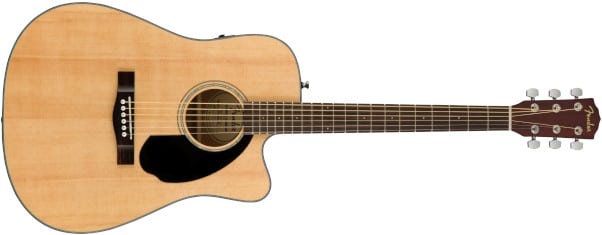
Are you looking for a straightforward acoustic guitar with fantastic sound and an appealing look? If so, the Fender CD-60SCE Dreadnought merits a serious look.
This guitar is a reliable performer, balancing easy play, flexible sound, and a friendly price tag in a way that’s tough to match.
Now, the CD-60SCE features Fender’s signature dreadnought shape. This design has been a favorite among guitarists for years.
But there’s a twist! This isn’t just your everyday dreadnought. It’s a cutaway model, letting you reach those higher notes with ease, perfect for solos or intricate finger picking.
The CD-60SCE comes with an exceptional feature, its solid spruce top. Spruce, a well-regarded tonewood, is known for its crisp, lucid sound, a characteristic that’s front and center in this guitar.
Adding to its tone are mahogany back and sides, introducing a touch of warm, rich nuance to the overall sound.
But the CD-60SCE really shines when it comes to its low action. The strings are set close to the fretboard, making them simpler to push down and reducing finger strain.
If you’re a newcomer building finger endurance, or a seasoned player seeking a comfortable play, this guitar has your back.
The CD-60SCE also packs Fishman electronics, along with a built-in tuner. You can amplify your songs for performances effortlessly, and maintaining perfect pitch is a breeze, regardless of your surroundings.
Of course, not every guitar can be flawless, and the CD-60SCE isn’t immune. Some might find the dreadnought shape a tad large or cumbersome, especially if they’re more familiar with compact-bodied guitars.
While its sound is generally well-rounded, it may lack the richness or complexity sought after by seasoned players.
Taylor Academy 10e

The Taylor Academy 10e acoustic guitar, where style meets substance. This isn’t your run-of-the-mill guitar! It’s a symbol of Taylor’s dedication to crafting gems that sound as amazing as they feel.
This guitar takes on the classic dreadnought form, hailed in the music scene for its hearty and evenly-toned sound. But here’s the twist. An innovative armrest for that extra touch of comfort when you’re strumming away.
Now, let’s talk about the top layer, made of solid Sitka spruce. Famous for its brilliant, crystal-clear sound, this wood type comes alive in the Academy 10e. The back and sidesn are made from layered sapele, bringing a full-bodied undertone to each note.
The star feature is undoubtedly, the low action of this guitar. Strings this close to the fretboard mean less effort and more comfort for your fingers. The Academy 10e makes playing feel like a breeze.
The Yamaha FG800
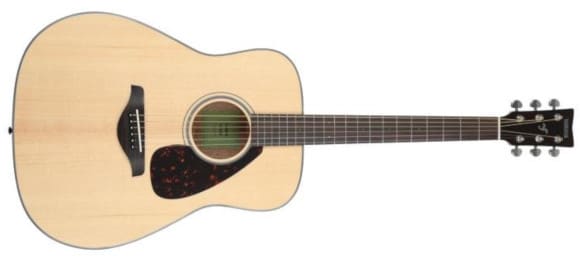
Let’s talk about the Yamaha FG800, a true standout in the world of acoustic guitars. This one doesn’t boast, it lets its remarkable sound and ease of playing speak volumes.
The FG800 comes in a classic design, the dreadnought, known and loved by many guitarists for its hearty and balanced tone.
Yet, this is not just your average dreadnought. This is a Yamaha, a name that stands for both top-notch quality and fair prices.
One of the key features of the FG800 is its solid spruce top. Spruce wood is famous for its crisp and clear tonality, and it truly shines in this guitar. The back and sides are crafted from nato wood, contributing a deep, rich undertone to the sound.
But where the FG800 truly excels is in its ease of use. The strings are easy to press down, thanks to the guitar’s low action, reducing the strain on your fingers.
The FG800 doesn’t come with electronics, offering you a purely acoustic performance. But the guitar is already remarkable in its acoustic form, and if you desire amplified sound, you can always add a pickup.
Keeping in mind the price tag, the Yamaha FG800 is truly unbeatable. It carries Yamaha’s dedication to maintaining a balance of quality and affordability, making it an excellent option for anyone seeking a trustworthy and user-friendly acoustic guitar.
Martin LX1E
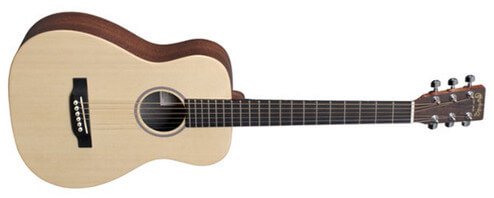
The Martin LX1E is a small yet powerful guitar, ideal for young players or those with smaller hands. Despite its size, this guitar, from the well known Martin brand with over a century of excellence, delivers impressive sound quality.
The guitar features a solid Sitka spruce top known for its clear, resonant tones. The back and sides are made from high-pressure laminate (HPL) mahogany, adding warmth to the sound.
Its low action design makes it easy to play, reducing finger fatigue, suitable for beginners and experienced players alike. The LX1E includes Fishman Sonitone electronics and an integrated tuner, making it performance-ready and easy to keep in tune.
However, the LX1E’s small size might be limiting for those used to full-sized guitars, and it may not meet the needs of players looking for more complex sound characteristics.
Taylor 214ce Grand Auditorium
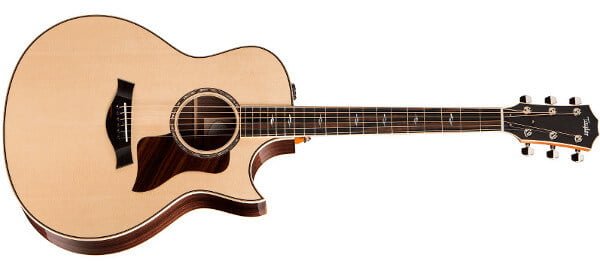
The Taylor 214ce Grand Auditorium is a top-tier acoustic guitar, exemplifying Taylor’s commitment to producing high-quality instruments that are a pleasure to listen to, hold, and play.
This Grand Auditorium style guitar is popular for its balanced and versatile sound. As a product of the Taylor brand, it represents a dedication to excellence and innovative design.
The 214ce features a top panel made of solid Sitka spruce, known for its clear, brilliant sound, which enhances the guitar’s tone. The back and sides are crafted from layered rosewood, adding depth and richness to the sound.
The guitar stands out for its playability, with a low string action that makes it easier to press the strings and reduces finger fatigue. This makes the 214ce enjoyable to play for both beginners and experienced guitarists.
Read my thorough Taylor 214CE review here!
Ibanez AW54CE
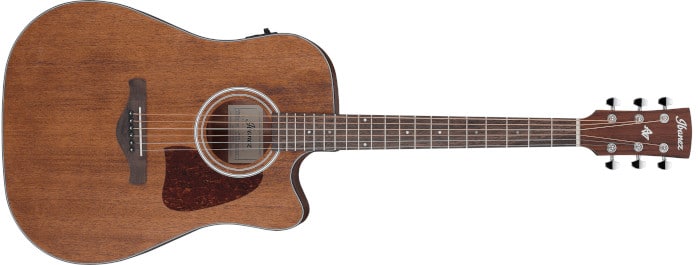
The AW54CE guitar features a body made entirely from okume wood, known for producing robust, resonant tones. This wood not only contributes to the guitar’s sound quality but also gives it a rich, vibrant character.
The AW54CE is designed to be player-friendly, with strings that sit close to the fretboard, reducing finger fatigue and facilitating long playing sessions.
It also comes equipped with an AEQ-TP2 preamp and built-in tuner, allowing for easy amplification and accurate tuning.
However, as a dreadnought-style guitar, its larger size may not be comfortable for all players.
It’s best suited for those who prefer a resonant, full-bodied sound. The AW54CE produces a warm, balanced tone, which may not be ideal for those seeking bright, sharp sounds. It is well-suited for players who enjoy melodies with richness and depth.
Taylor GS Mini

The Taylor GS Mini excels in sound quality, craftsmanship, and playability, showcasing Taylor’s innovative approach and commitment to creating superior musical instruments.
Its compact size makes it perfect for young players, those with smaller hands, or anyone needing a portable guitar.
The GS Mini features a solid mahogany top known for warm and clear tones, which are especially pronounced in this model. The back and sides are made from layered sapele, adding a rich, cozy quality to the sound.
Equipped with Taylor’s ES-B electronics and a built-in tuner, the GS Mini allows for easy amplification and accurate tuning wherever you are.
The standout feature of the GS Mini is its playability, with a low action that reduces string pressure and finger fatigue. This makes it a comfortable option for both beginners and experienced players looking for an easy-to-play guitar.
Steps to Lower the Action on an Acoustic Guitar
If your guitar has high action and your fingers are taking a beating, fear not! It’s more than possible to give your acoustic a quick tweak and correct the condition. In most cases, the neck just needs to straighten a bit.
- Gather Your Tools: You’ll need a ruler or action measuring tool, a set of automotive feeler gauges, and a hex wrench or screwdriver that fits your guitar’s truss rod.
- Check the Current Action: Measure the distance between the bottom of the sixth string (the thickest one) and the top of the 12th fret. This is your current action.
- Adjust the Truss Rod: If the action is too high, you’ll need to tighten the truss rod, which is located inside the guitar neck. Use your wrench or screwdriver to turn the truss rod clockwise. If the action is too low, turn it counterclockwise. Be careful, only make small adjustments at a time.
- Recheck the Action: After adjusting the truss rod, give the guitar 12 hours to adapt to the adjustment. Then measure the action again. If it’s still not right, repeat step 3.
- Adjust the Saddle: If adjusting the truss rod doesn’t lower the action enough, you may need to sand down the saddle. This is a more advanced step and may be best left to a professional.
Conclusion
Understanding various guitar types, especially low action acoustics, is crucial for enhancing your musical experience. These guitars offer a combination of easy playability, sound quality, and versatility, suitable for different music and playing techniques.
Our exploration into top-tier low-action acoustic guitars introduced us to brands like Martin, Taylor, and Yamaha.
Each of these guitars has its unique strengths, but they all share the common feature of providing a smooth playing experience with minimal finger pressure.
Choosing the right guitar depends on your preferences, playing style, and budget. It’s important to research, try out different models, and make an informed decision.

